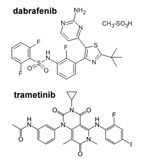ESMO: BRAF/MEK Inhibitor Combo Bests Monotherapy for Metastatic Melanoma
Phase II results presented at the ESMO 2012 Congress showed a 3.6-month improvement in progression-free survival for patients receiving both dabrafenib plus trametinib compared to those receiving dabrafenib alone.
Phase II results presented at the European Society for Medical Oncology (ESMO) 2012 Congress showed a 3.6-month improvement in progression-free survival (PFS) for patients receiving both the BRAF inhibitor dabrafenib and trametinib, a MEK inhibitor, compared to those receiving dabrafenib alone.
PFS was 9.4 months for patients who received dabrafenib plus trametinib compared to 5.8 months in patients who received dabrafenib alone (HR = 0.39, P < .0001), according to Georgina Long, MD, of the Westmead Hospital and the Melanoma Institute Australia at the University of Sydney, who presented the study at ESMO. Response rates were 75% for those in the combination group compared to 54% in the monotherapy group (P = .026). The median duration of response was 10.5 months with the combination compared to 5.6 months for the BRAF monotherapy. The results are published in the New England Journal of Medicine (NEJM).

Chemical structure of dabrafenib and trametinib
The phase II trial randomized 162 metastatic melanoma patients who harbor the activating V600E BRAF mutation. Patients were randomized 1:1:1 to 150 mg twice daily dabrafenib and either placebo, 1 mg trametinib once daily, or 2 mg trametinib once daily.
“The randomized phase II data presented by Georgina Long at ESMO last week and in the NEJM article clearly suggest that there is a superior response rate and median PFS for the combination compared to dabrafenib alone,” said senior author Jeffrey S. Weber, MD, PhD, melanoma oncologist and immunologist at the Moffitt Cancer Center in Tampa, Florida.
Dr. Weber added that the survival data are still premature. Dr. Weber stated that despite a missing vemurafenib arm in the trial, the combination is likely to also be superior to vemurafenib monotherapy.
Vemurafenib, manufactured by Roche, a V600E BRAF oral inhibitor approved in August of 2011 for metastatic melanoma patients who are BRAF-positive, is now considered standard of care for the approximately 40% of metastatic melanoma who harbor a BRAF mutation. BRAF is part of the mitogen-activated protein kinase (MAPK) pathway.
Dabrafenib is also a V600E BRAF oral inhibitor and is developed by GlaxoSmithKline. A phase III randomized trial comparing dabrafenib to chemotherapy showed a statistically significant improvement in PFS.
Trametinib, an inhibitor of MAPK kinase (MEK), a protein downstream of BRAF in the MAPK pathway, has also shown improvement of PFS and overall survival in a phase III trial.
Patients treated with a BRAF inhibitor eventually develop resistance. Approximately 50% of these BRAF-treated patients have documented progressive disease within 6 or 7 months of the start of treatment. Combining both drugs, researchers reasoned, would delay or even prevent resistance mechanisms to arise; preclinical models suggested this to be the case.
The combination therapy reduced well-documented skin toxicities such as squamous cell carcinoma (SCC) seen with BRAF monotherapy. Grade 3 or higher SCCs were seen in 17% of patients treated with dabrafenib monotherapy compared to 2% and 5% of patients treated with dabrafenib and either 1 mg daily trametinib or 2 mg daily trametinib, respectively.
“The skin toxicities of the [dabrafenib plus trametinib] combinations are clearly lower than that seen with the BRAF drugs alone, either dabrafenib or vemurafenib,” said Weber. “This was predicted by preclinical models.”
Pyrexia and chills were the most common adverse events reported. In the combination arms, pyrexia was seen in 71% of patients and chills were experienced in 58% of patients. In her presentation, Dr. Long stated that fever and chills were prevented with corticosteroids.
“Pyrexia will turn out to be a significant annoyance, as evidenced by a high rate of dose adjustments for pyrexia [seen in the study],” said Kim Margolin, MD, oncologist at the Fred Hutchinson Cancer Center in Seattle, who specializes in melanoma. Dr. Margolin, who was not part of this trial, added that it is not likely that there will be incidences of complicated pyrexia cases as seen in a few cases of dabrafenib monotherapy treatment.
New drug applications have been submitted to the US Food and Drug Administration for both trametinib and dabrafenib monotherapy for the treatment of BRAF-positive metastatic melanoma in August of 2012. The drugs have also been submitted to the European Medicines Agency for approval. The combination dabrafenib plus trametinib is currently in two phase III trials for metastatic melanoma.
“The combination has a good likelihood, in my view, of replacing single drug therapy. The only increased side effects seen with the BRAF plus MEK combination is the pyrexia, which is manageable but annoying for patients and physicians,” Dr. Weber commented.
“It’s very likely that the overall balance of toxicities will be neutral and that the increased antitumor activity and duration of control will far outweigh the side effect profile of combination therapy,” said Margolin. For those patients who cannot tolerate combination therapy, it will be hard to know which agent, dabrafenib or trametinib, to consider, Margolin added. Subsequent trials could provide this information.
“Since there aren’t any other good examples of tolerable combination targeted therapies, this is groundbreaking information,” said Dr. Margolin.